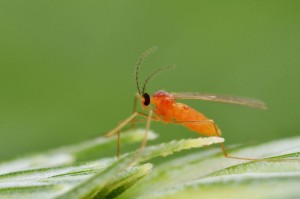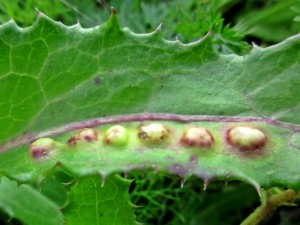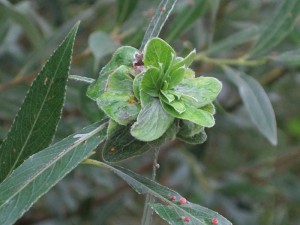Gall midges are a family of mosquitoes (Cecidomyiidae), which consists of at least 783 genera and 6000 species worldwide. This makes the gall midge the most species-rich mosquito family on the planet. In Denmark, it is estimated that there are around 600 species of gall midge.
One of the most characteristic features of gall midges is that their presence on a plant results in so-called grate. These galls are outgrowths or growth deformities on the plant and are a very central part of the mosquito life cycle.
Gall midge control products can be purchased here.
Control of gall midges
Gall midges can be considered pests when they form galls on plants that we grow. These can be vegetable plants, berry bushes, crops and trees, but also flowers and other ornamental plants.
In private households, there is generally no reason to try to control gall midges, as it is very difficult and, in some cases, futile. This is mainly due to the fact that gall midge damage to plants is usually not very extensive, but also that chemical pesticides and the like will in most cases do more harm than good because they will typically hit the natural enemies of the gall midge harder than the gall midge.
The natural enemies of gall midges are mainly parasitic midges, which lay their eggs in the galls. The larva of the parasitoid eats the gall midge in the gall and then reproduces, allowing the next generation of parasitoids to fight the gall midge. Thanks to natural enemies, gall midges usually disappear over time.
Gall midge control products can be purchased here.
Description
LengthGal mosquitoes are very small and fragile insects that can normally grow up to 3 mm long, but typically only measure around 1 mm. In some species, mosquitoes can rarely reach up to 8 mm in length. The smallest species are only 0.5 mm in length.
Wings: They can be recognized by their hairy wings, which are otherwise unusual in their order (Diptera). The wings are almost always clear, but in rare cases can have patterns.
AntennasAlmost all gall midges have very long antennae (antennae), which usually consist of 12-14 segments. However, in some species the antennae can consist of up to 40 segments and in others the number can be less than 12.
ColorsGall midges are often yellowish, orange or reddish (or a color in between). Larvae are usually yellowish or reddish, but can also be whitish.
Jelly
As mentioned, galls are the outgrowths or growth deformities that gall midge larvae cause on plants. The galls appear when the larvae feed on the flesh of the plant.
The galls act as a kind of nest in which the adult gall midge lays its egg. It protects the egg from predators and environmental influences. The first part of the gall is already formed when the adult mosquito lays its eggs in the plant. When the larva hatches from its egg, it secretes hormones that cause the gall to change shape, color and texture, making it more distinctive overall.
Galls are caused by gall midge larvae
In some climates - such as the temperate climate found in Denmark - the gall midge larvae overwinter in the galls. This is the case on the creeping willow plant (Salix repens repens), where a so-called willow rose - a gall on the tip of the willow shoot - is formed. In winter, these types of galls are easy to spot as they are the only places on the willow where there are still leaves.
On the creeping willow, the gall is called a 'willow rose'
Reproduction
Some species of gall midge have special reproductive characteristics, for example, they can reproduce in the larval or pupal stage without prior mating.
If the larvae have access to sufficient food, they can reproduce in this way for several generations without producing adult mosquitoes.
In some species, the offspring can also eat their parents.
Gall midges as pests and beneficial insects
The larvae of gall midges are the real pests, as they are the ones that eat the plant tissue and form galls that damage the plants. In other words, it is the larvae of the plant-infesting gall midges that can rightly be considered pests.
However, it should be mentioned that galls are not always a problem; if they do not inhibit the growth of the plant or if the plant is not a crop, ornamental plant or similar, galls are not a problem.
Furthermore, not all gall midge species feed on living plants; many feed on bark, fungi, dead plant material, etc.
There are also some species of gall midge whose larvae do not feed on plant materials, but on other mites and insects - you can read more about them below.
Predatory caterpillars
A large number of gall midge species are natural enemies of other pests that live on the same host plants as mosquitoes. The larvae of some gall midge species are predatory and some are even parasitoid. The most common prey of these larvae are aphids and spider mitesfollowed by scale insects, and then other small prey such as mellus and thunderflies.
Because the larvae don't move around much, there needs to be a sufficiently concentrated population of prey before adult gall midges lay eggs. This is why gall midges are often seen in heavy pest infestations.
Some species of gall midge are used for pest control. This is the case with aphids, for example, where the larvae of the aphid gall midge suck out the aphids and can be used to control them in greenhouses and the like.
Galmygge species
There are at least 6000 gall midge species in the world and an estimated 600 in Denmark. Many of the species do not yet have Danish names, but a large number of those that do can be seen in the list below:
- Maple curl gall midge (Dasineura irregularis)
- Common juniper gall midge (Oligotrophus juniperinus)
- Arabian Palm Mosquito (Dasineura alpestris)
- Astragalus Stalked Palm Mosquito (Dasineura astragalorum)
- Birkeraklegal mosquito (Dasineura fastidiosa)
- Aphid gall midge (Aphidoletes aphidimyza)
- Blackberry leaf gall midge (Dasineura plicatrix)
- Boxwood gall midge (Monarthropalpus flavus)
- Beech curl gall midge (Phegomyia fagicola)
- Beech shoot gall midge (Contarinia fagi)
- Ribbon willow leaf gall midge (Rabdophaga marginemtorquens)
- Daylily gall midge (Contarinia quinquenotata)
- Draphavregalm mosquito (Contarinia arrhenatheri)
- Oak pod mosquito (Arnoldiola quercus)
- Elder leaf gall midge (Dasineura tortilis)
- Forget-me-not mosquito (Dasineura myosotidis)
- Fredless Palm Mosquito (Contarinia lysimachiae)
- Pine needle spoon gall midge (Thecodiplosis brachyntera)
- Goat beard mosquito (Contarinia tragopogonis)
- Spruce seed midge (Plemeliella abietina)
- Grankoglegal mosquitoes (Kaltenbachiola strobi)
- Yellow wheat midge (Contarinia tritici)
- Carrot gall midge (Kiefferia pericarpiicola)
- Hasselrakleglegal mosquito (Contarinia coryli)
- Hessian gall midge (Mayetiola destructor)
- Raspberry stem gall midge (Lasioptera rubi)
- Elderflower gall midge (Placochela nigripes)
- Hairy beech leaf gall midge (Hartigiola annulipes)
- Cat-tail mosquito (Bayeriola salicariae)
- Clover leaf gall midge (Dasineura trifolii)
- Clover flower gall midge (Dasineura leguminicola)
- Cobweb gall midge (Dasineura pulsatillae)
- Cornelian midge (Craneiobia corni)
- Cricket mosquito (Contarinia nasturtii)
- Chrysanthemum gall midge (Rhopalomyia chrysanthemi)
- Cinnamon tooth flower gall midge (Contarinia loti)
- Small birch seed smoke mosquito (Semudobia betulae)
- Lime leaf roller gall midge (Dasineura tiliae)
- Lime blister gall midge (Didymomyia tiliacea)
- Lime curl gall midge (Dasineura thomasiana)
- Alfalfa leaf gall midge (Jaapiella medicaginis)
- Lucerne flower gall midge (Contarinia medicaginis)
- Lark gall midge (Dasineura kellneri)
- Meadowsweet Palm Mosquito (Dasineura ulmaria)
- Mycelial mosquitoes (Mycophila speyeri)
- Dandelion gall midge (Cystiphora taraxaci)
- Nightshade mosquito (Contarinia solani)
- Umbilical crusted gall midge (Dasineura rubella)
- Carnation root midge (Contarinia gei)
- Nile purse gall midge (Dasineura urticae)
- Ocular Palm Mosquito (Resseliella oculiperda)
- Orange-yellow wheat midge (Sitodiplosis mosellana)
- Orange-red ash gall midge (Dasineura fraxini)
- Willow twig gall midge (Rabdophaga salicis)
- Pileroset Palm Mosquito (Rabdophaga rosaria)
- Arrowhead midge (Rabdophaga terminalis)
- Arrowhead Palm Mosquito (Wachtliella persicariae)
- Arrowwood Palm Mosquito (Rabdophaga saliciperda)
- Poplar leaf roller gall midge (Dasineura populeti)
- Pear leaf gall midge (Dasineura pyri)
- Pear gall midge (Contarinia pyrivora)
- Razorback midge (Semudobia skuhravae)
- Rape grass gall midge (Mayetiola schoberi)
- Reindeer flies (Rhopalomyia tanaceticola)
- Robinia gall midge (Obolodiplosis robiniae)
- Rose petal gall midge (Dasineura rosae)
- Foxtail mosquito (Dasineura alopecuri)
- Reed canary gall midge (Mayetiola phalaris)
- Saddleback mosquito (Haplodiplosis marginata)
- Scaly gall midge (Dasineura napi)
- Blackcurrant leaf gall midge (Dasineura tetensi)
- Pointed beech leaf gall midge (Mikiola fagi)
- Jumping flax gall midge (Contarinia tiliarum)
- The common gramineous mosquito (Dasineura violae)
- Stingray Palm Fly (Dasineura saxifragae)
- Stonefly mosquito (Dasineura lithospermi)
- Stalk gall midge (Mayetiola hellwigi)
- Large birch seed midge (Semudobia tarda)
- Swallow Palm Fly (Jaapiella chelidonii)
- Pork Milk midge (Cystiphora sonchi)
- Roofing gall midge (Taxomyia taxi)
- Thorn rose gall midge (Dasineura crataegi)
- Tretorn Palm Mosquito (Dasineura gleditchiae)
- Poppy gall midge (Dasineura papaveris)
- Ivy gall midge (Dasineura kiefferi)
- Plantain gall midge (Jaapiella schmidti)
- Violet mosquito (Dasineura affinis)
- Hawthorn gall midge (Wachtliella krumbholzi)
- Apple leaf gall midge (Dasineura mali)
- Noble cypress gall midge (Cupressatia siskiyou)
- Norway spruce smoke mosquito (Resseliella piceae)
- Reverend Palm Mosquito (Jaapiella veronicae)
- Pea gall midge (Contarinia pisi)
Please note that not all gall midges with Danish designations necessarily live in Denmark!



